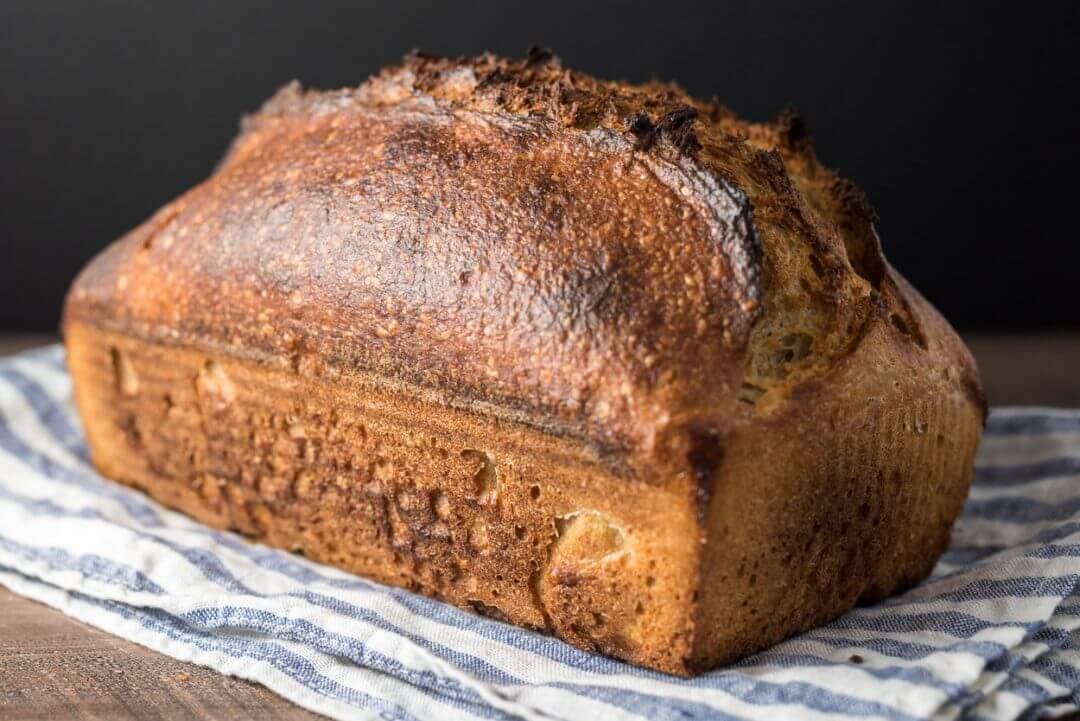As a kid, I recall more often than not eating baguettes brought home from my Dad’s restaurant, usually procured through a late-night call asking for “some bread for tomorrow.” On the weekends my Mom and Grandmother would slice these baguettes at a super slanted angle and make French toast, probably one of the perfect bread for such a thing, but aside from these baguettes we also had a sack of pre-sliced whole wheat bread—which coincidentally also makes excellent French toast in a different sort of way. It was always whole wheat (even before that was the in thing to buy), and it was mostly just a vehicle for peanut butter & jelly, cinnamon & sugar, straight butter, or whatever other bright things kids can dream up. I always preferred the baguette with its wonderfully crunchy crust. But, there’s a special place for a PB & J sandwich—especially now with this whole wheat sourdough sandwich bread—that has so much peanut butter when dropped it would always land on the peanut butter side.
“Why don’t we ever have good
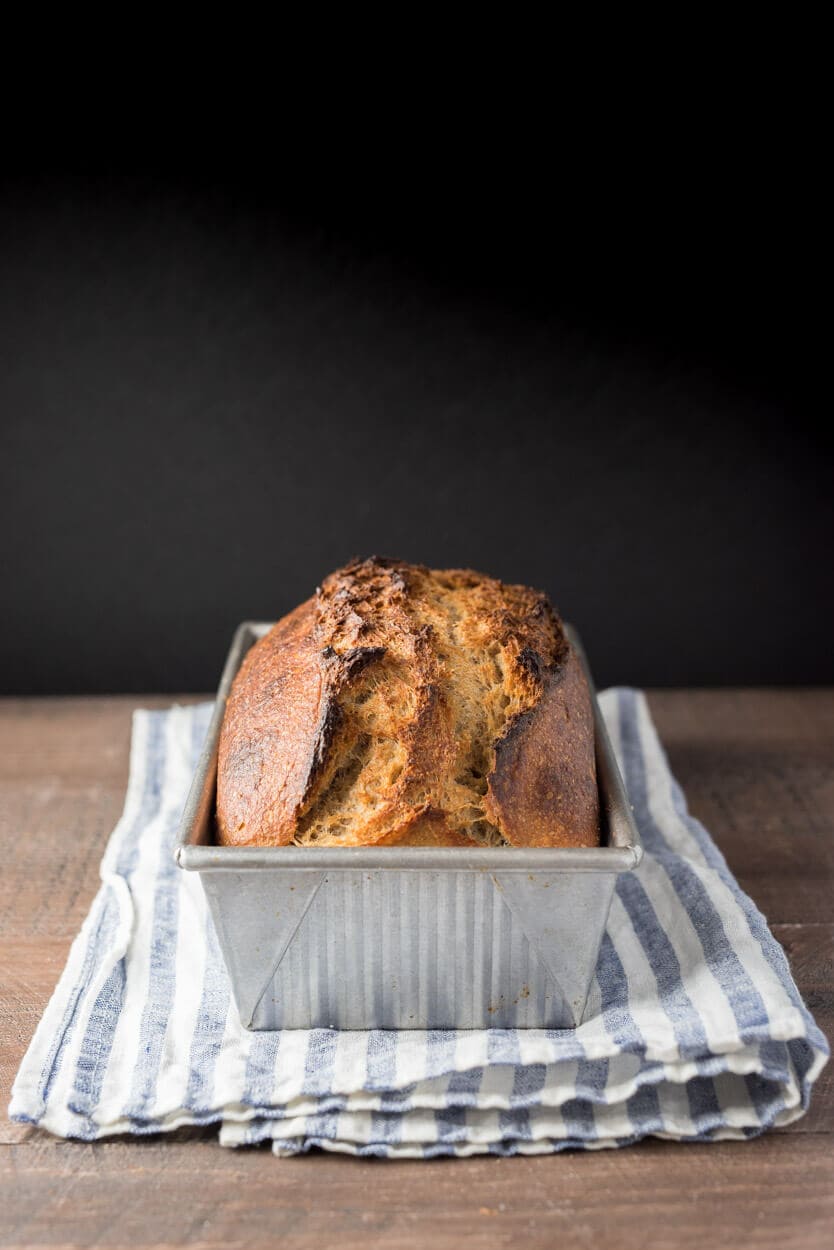
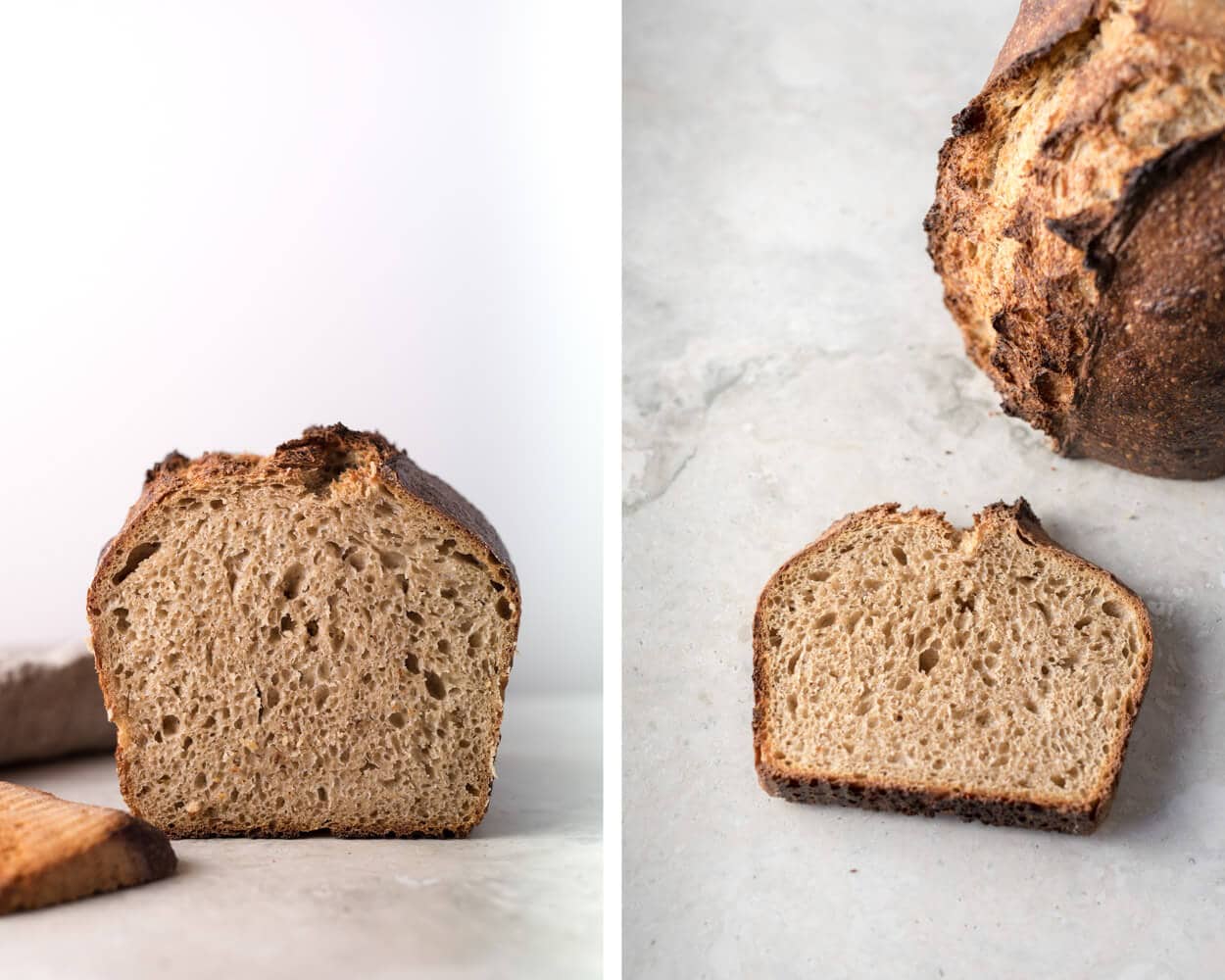
The perfect sandwich bread to me is related to that sacked bread from the supermarket, but only in the most remote way possible—perhaps only in the fact that it’s square-ish and sliced. I want a thin and shiny crust with a moist and light interior, a slightly sweet taste not from honey or sugar but from the whole grain itself. And that’s important: I want to taste the grain in this bread, not some strange flavor masked by something sweet. The interior should be tight but still light and well fermented, coaxing out maximal flavor from the grain. As far as aesthetics go, you can alter the way this bread rises and opens (or doesn’t open) at the top to suit your taste. I still prefer to impart my signature rustic feel and dark bake, but the final tweaks are up to you.
But first, let’s talk about flour.
Flour Selection
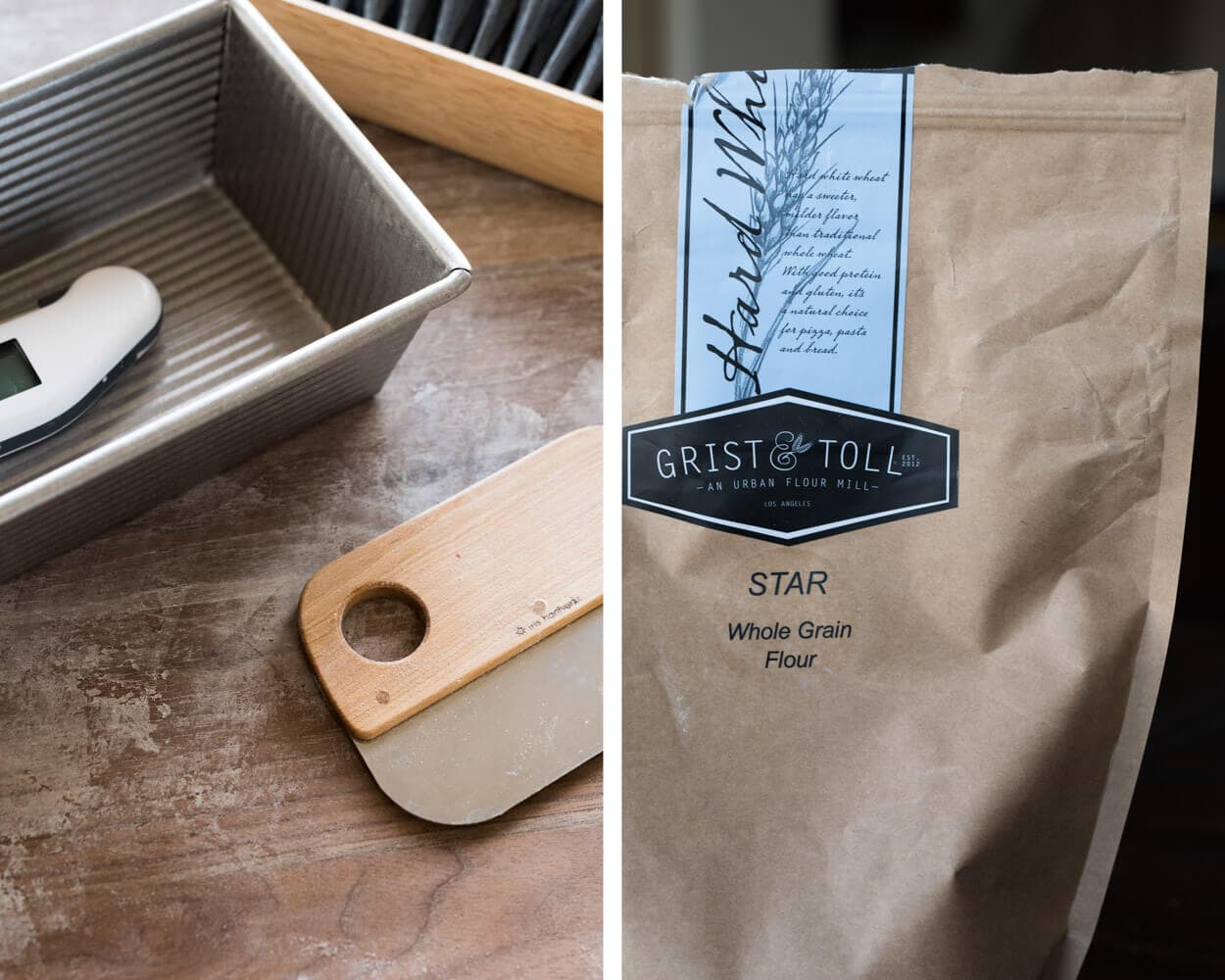
I chose white whole wheat for this recipe because I love the sweet flavor of it, especially compared to red whole wheat which can have a slight bitterness that sometimes pushes through. For the bakes leading up to this post, I used Grist & Toll Star White Whole Wheat. I’ve found the flour to be quite strong (regarding protein) with no gummy flavor to it, which is nice. I recommend using white wheat (King Arthur White Whole Wheat will work well, too) for this recipe but if you don’t have any on hand red wheat will work just fine — the flavor profile will be slightly different but still in the same vein. The small amount of red whole wheat was mostly used to build my levain (per usual) but also because it does add a slightly sharp flavor to the bread, just enough to balance out the sweetness. If you’re more a fan of the white wheat, sub the 10% red for white in the formula below.
If you remember, my recent Spelt Sourdough entry also used type 85 flour, and I explained there that this could be approximated by mixing 65% white bread flour with 35% whole wheat. In this formula, I’m only using a small percentage so again, feel free to mix whole wheat & bread flour to get the desired quantity or sub it out for another blend.
In the end, I like the flavor and characteristics imparted by these flour choices, but it is flexible. I know sometimes we want to bake bread with what we have in our pantry and not have to go out and buy special flour—by all means, experiment (and please let me know how your modifications turn out)!
Whole Wheat Sourdough Sandwich Bread Formula
A word of warning upfront: this formula has a very high hydration; the structure of the pan helps keep this dough together and permits me to push water as far as the flour will take it. This amount of water imparts a significantly moist and soft texture to the interior that is typical of sandwich bread, and the results are definitely worth the added hardship of dealing with such a wet dough.
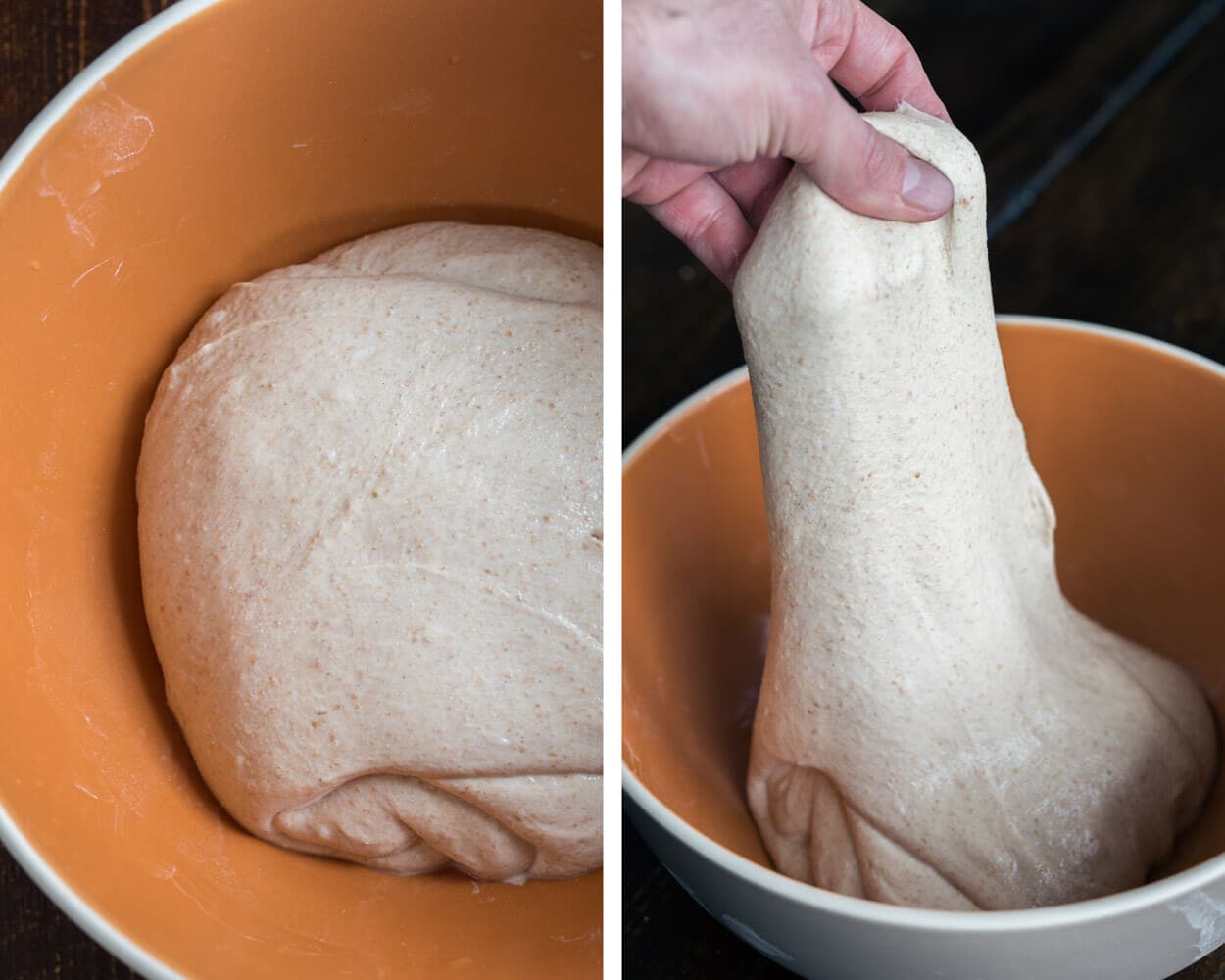
Keep in mind that your flour will act differently with all this water added so hydrate accordingly. Start with a lower percentage and work your way up until you find the perfect point for your flour mix. The dough should be wet looking, extensible, and very soft, but it should not be overly “soupy” or falling apart—if this happens hydration is too high for your flour. You can see below what my dough looked like right after mixing. After a bit of practice, this bread becomes easy to make, and you can double the formula to make two pans at a time. I see myself making this bread reasonably often, freezing one loaf and using the other, this way we always have sliced whole wheat sourdough sandwich bread at the ready.
Vitals
| Total Dough Weight | 1,200 grams |
| Pre-fermented Flour | 5.00% |
| Hydration | 90% |
| Yield | One loaf in a 9” x 5” x 2.75” pan |
The USA Pan used for this bake has a silicone coating, and while I lightly oil the pan with olive oil I don’t think it’s necessary—I have yet to have anything stick to this thing. It’s heavily used here in my kitchen mostly for my sourdough banana bread but now also traditional sandwich bread and even sourdough tea cakes.
Levain Build
| Weight | Ingredient | Baker’s Percentage |
|---|---|---|
| 15g | Ripe liquid starter (100% hydration) | 50% |
| 15g | Giusto’s Stoneground Whole Wheat | 50% |
| 15g | Central Milling Type 85 | 50% |
| 32g | Water | 100% |
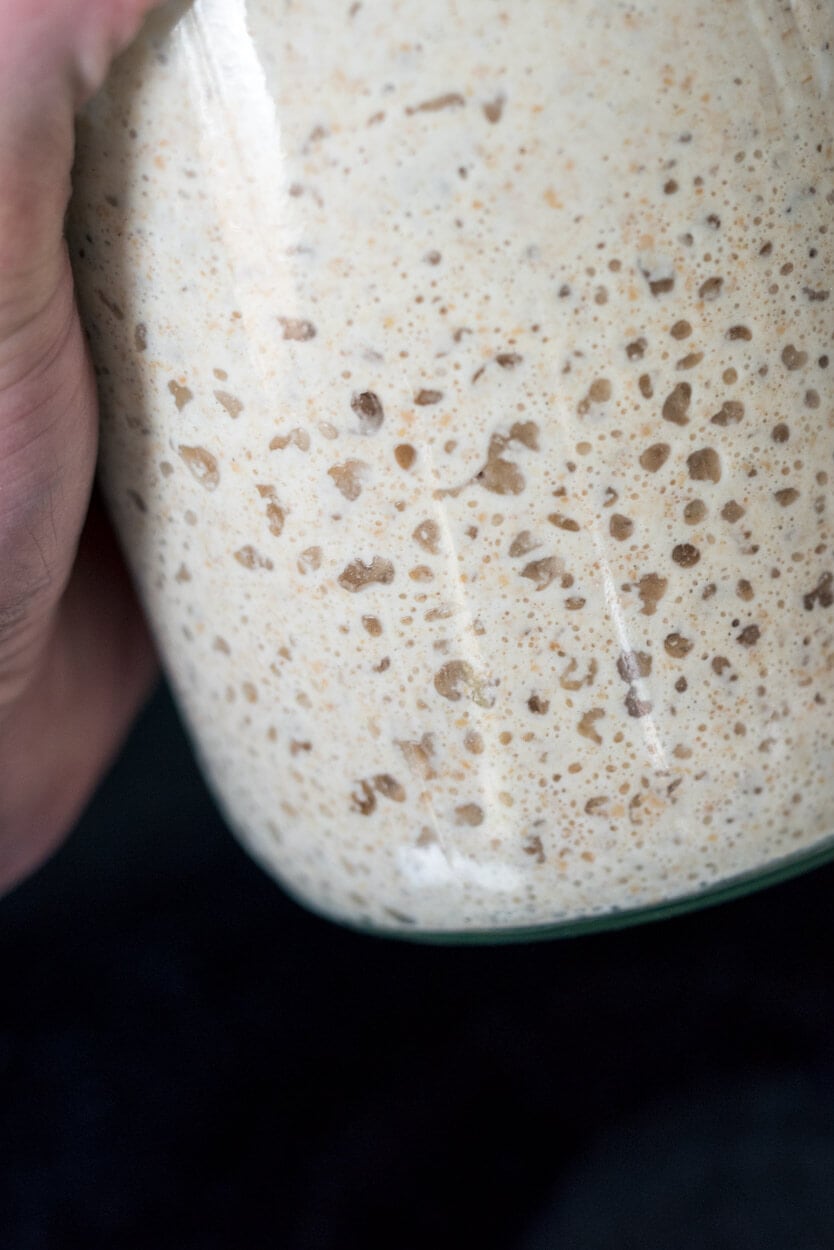
I used half Central Milling type 85, and half Giusto’s whole wheat for the levain build, but you can change this up if you’d like (e.g., use 100% whole wheat or 100% white whole wheat) just keep an eye on its fermentation rate as a higher percentage of pure whole wheat will peak much faster.
Dough Formula
After a few trials, I arrived on a final dough weight of 1200 grams for my bread pan. The resulting bread was nicely sized and perfect for what I’m looking for, but I think it could be pushed even further, perhaps somewhere around 1300-1400 grams if you want an even taller loaf, one that rises and slightly spills over the edges.
Note that the baker’s percentages listed below are with respect to the final dough ingredients and do not take into account the levain.
The target final dough temperature (FDT) is 75°F (24°C).
| Weight | Ingredient | Baker’s Percentage |
|---|---|---|
| 463g | Grist & Toll Star White Whole Wheat | 78.95% |
| 77g | Central Milling Type 85 | 13.16% |
| 46g | Giusto’s Stoneground Whole Wheat | 7.89% |
| 524g | Water | 89.47% |
| 12g | Fine sea salt | 2.11% |
| 77g | Ripe, liquid levain | 13.16% |
Method
1. Levain – 9:00 a.m.
Build the liquid levain in the morning and store somewhere around 78°F (25°C).
2. Autolyse – 1:00 p.m.
For the autolyse, mix flour and water (reserve 100g of the total water for later mixing) in a bowl until all dry bits are hydrated. Cover bowl and store somewhere warm (around 78°F/25°C) for 2 hours.
3. Mix – 3:00 p.m.
Due to the high hydration of this dough, it’s helpful to build some strength at the start of mixing before adding in the reserved 100g of water.
Add the mature levain and about 25g of the reserved water, mix thoroughly by hand to incorporate, and then slap and fold for about 6 minutes, just until the dough starts to show signs of a smooth surface and holds its shape on the counter. If you aren’t comfortable with this method or don’t like it, you can perform stretch and folds in the bowl until your dough tightens up and is slightly hard to stretch out and fold over—close to medium development.
When finished sprinkle the salt on top of the dough and use the remaining 75g of water (or less if the dough is starting to feel too wet and falling apart) to help dissolve. Pinch through a few times and fold the dough over itself to help incorporate. Keep folding the dough until all the water is absorbed and it comes together; it will end up slightly sticky.
Transfer dough to a tub or thick-walled bowl for bulk fermentation.
4. Bulk Fermentation – 3:20 p.m. to 7:00 p.m.
At 78°F (25°C) ambient temperature bulk fermentation should go for a little less than 4 hours. Watch the dough! With this much whole grain, it’s possible your dough could ferment faster than mine.
Perform five sets of stretch and folds during the bulk, spaced out by 30 minutes (the first set starts 30 minutes after you finish mixing). After the fifth set of stretch and folds, performed gently, let rest for the remainder of bulk. The dough will not rise an incredible amount, but it should be slightly jiggly and some bubbles on top and sides. You want to see a slightly convex edge between the dough and the bowl.
5. Pre-shape – 7:00 p.m.
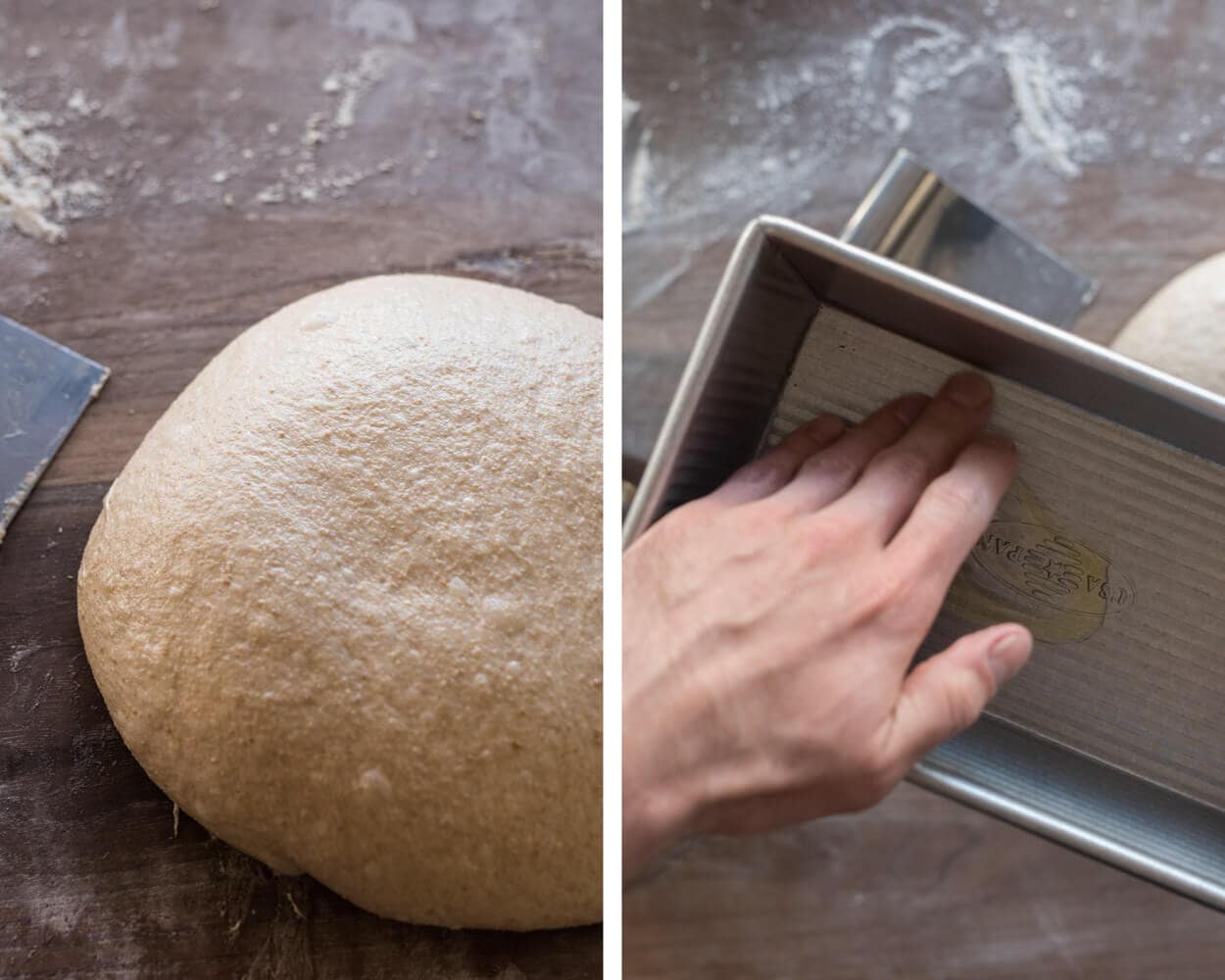
Sprinkle a light dusting of flour on your bench and dump out the dough. Shape into a single round mass and let rest 20 minutes uncovered. Because this dough is highly hydrated, rely mostly on your bench knife and try to touch the dough as little as possible. I use my knife to pick up and pull the mass around in a circle, forming a relatively tight skin on the dough. Using a little olive oil lightly oil the baking pan.
6. Shape – 7:25 p.m.
Shaping this dough can be challenging. The good news is it’s pretty hard to mess it up, just form it as best you can into a “tube” the width of the baking pan and get it in there with as much tension on the surface as possible. The structure of the pan will force your dough to rise upward whereas with a hearth loaf we’d have to ensure a proper shape so there’s no spreading in the oven.
Moderately flour the top of the dough and flour the work surface. Flip the resting round over onto the floured surface and fold the side edges at the top up and over to the middle (imagine a round bottom that tapers up to a point at the top, it will look like an inverted diamond of sorts). With floured hands take the point at the top and start to roll the entire mass of dough downwards, with each roll pushing the dough with your thumbs inward toward the bench—imagine rolling up a beach towel. At the end of this, you’ll have a tube that has essentially been rolled downward. Transfer to your oiled pan with the seam on the bottom.
An alternative shaping method that might be easier to perform is to just fold the sides slightly up and over towards the middle, then roll up the dough tightly. It won’t be as spread out to the sides, but the dough should relax in the pan overnight.
For more information and photos on shaping, proofing, and scoring pan loaves check out my guide to shaping pan loaves.
7. Rest & Proof – 7:30 p.m.
Cover your pan with plastic and then retard in the refrigerator at 38°F (3°C) for 10-14 hours. Even at such cool temperatures this dough can quickly overproof so keep an eye on it in the fridge in the morning.
8. Bake – Next Morning: Preheat oven at 6:00 a.m., Bake at 7:00 a.m.
Preheat oven for one hour at 450°F (230°C).
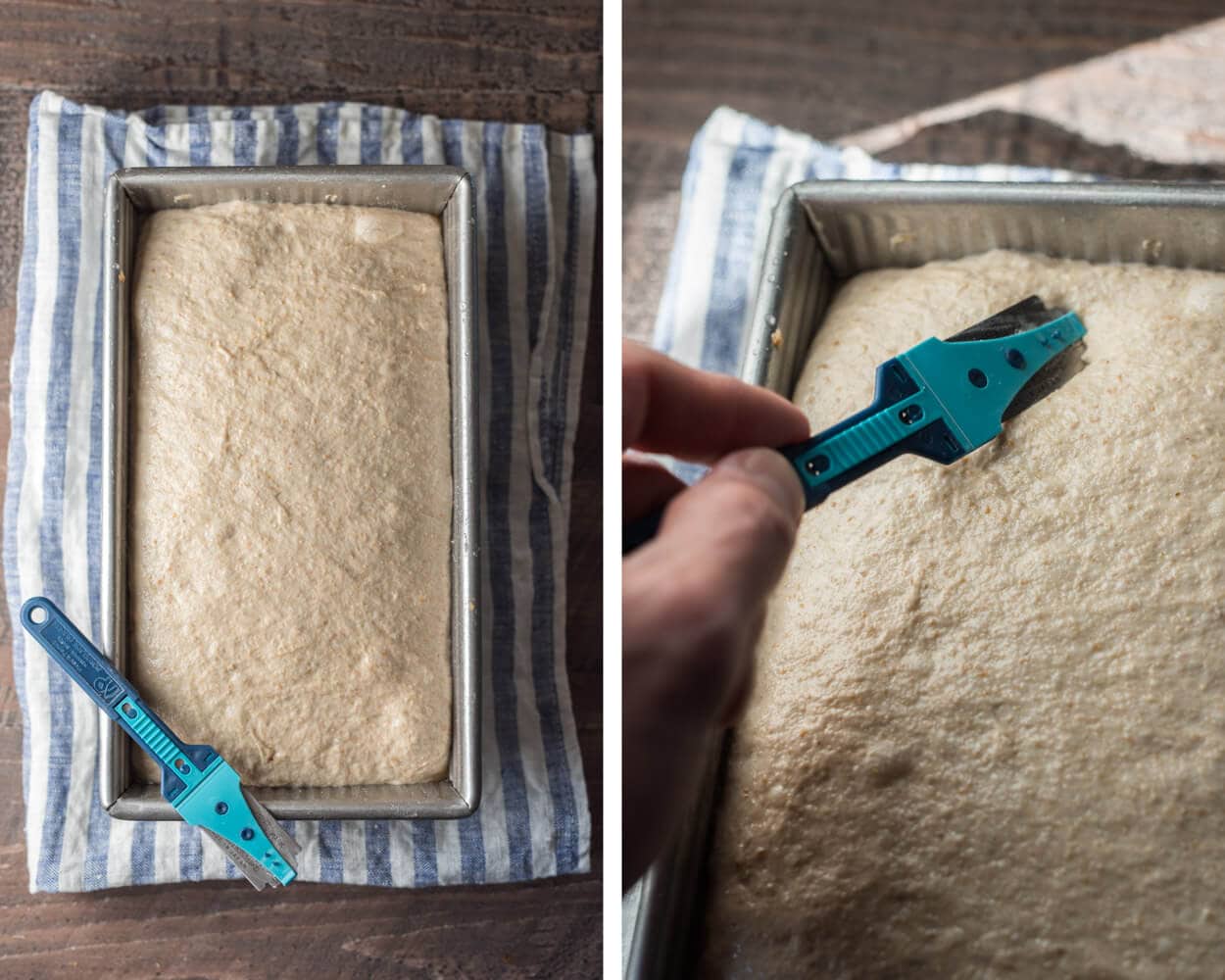
I did a very rough score on the top of the dough before placing into the oven. If you choose not to score at all, you’ll most likely get a taller loaf, and depending on how tight you shaped your dough, there may be more or less of a rupture on top. In the future, I’d like to play with an even longer proof in the fridge with no score at all. This should yield an even more tender crumb and hardly any dramatic fissure. I cut a rectangular piece of parchment paper and set it directly on my baking surface, just in case the heat was a little too high for the pan to handle.
Spritz the top of the dough in the pan with a hand mister and place it into the oven on the parchment paper. Bake for 20 minutes at 450°F (230°C) with steam, and an additional 30 minutes at 450°F (230°C) without steam. Then, turn the oven down to 425°F (220°C) and bake for an additional 15-20 minutes until done (the internal temperature on my loaf was 205°F/96°C).
I steamed the oven in my usual way, described here in my post on how to steam your home oven for baking. While this extra steam might not have been necessary, I wanted to ensure maximal rise and a thin & crisp crust. Remove from the oven and let cool in the pan on a wire rack until cool enough to remove the bread from the pan, then remove and let cool directly on the wire rack for a few hours.
If you cut this bread too soon, the interior may not be wholly set so give it a little time to relax (here’s why).
Conclusion
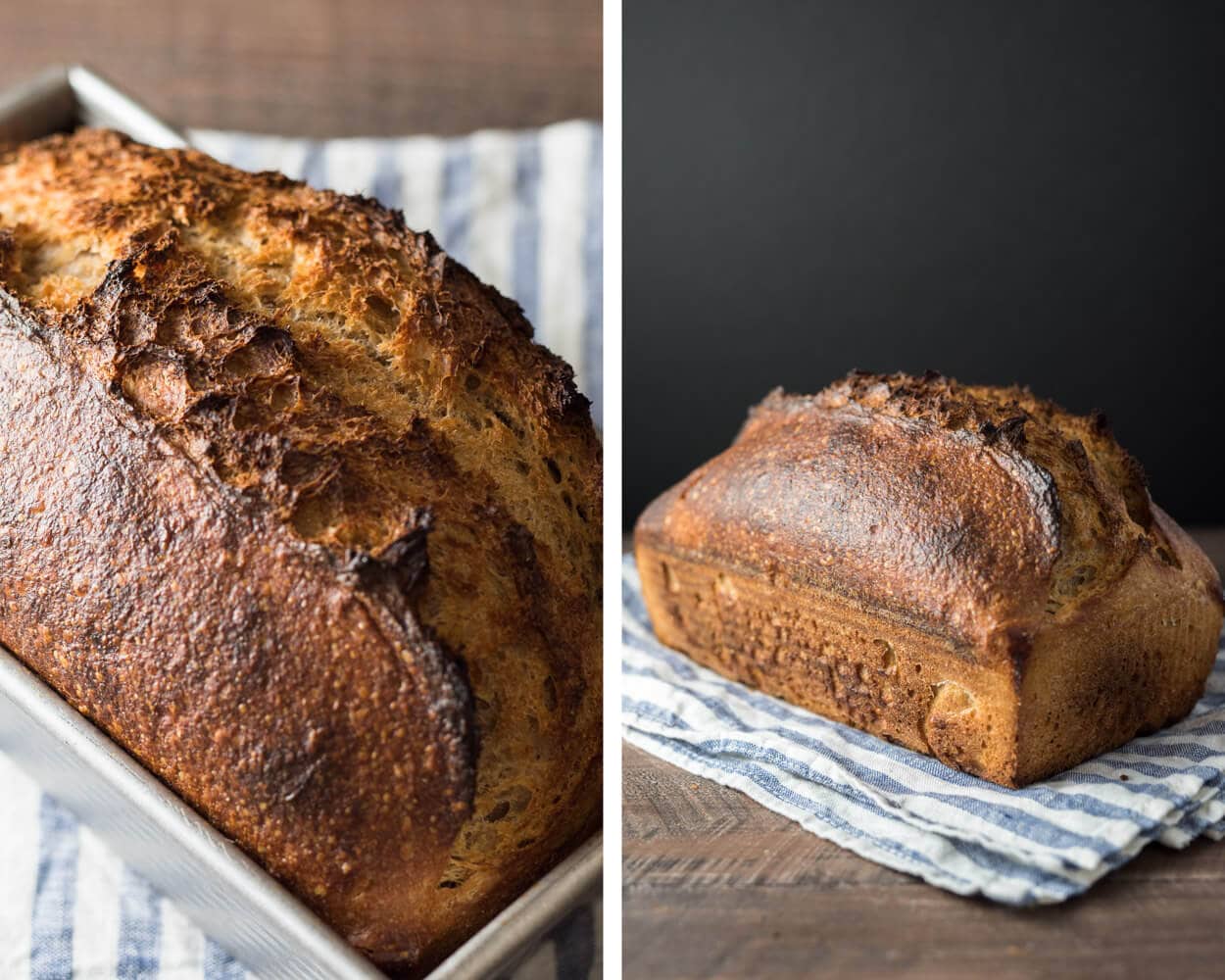
With only four ingredients this healthy bread is a daily bread that has a mellow, sweet taste. The crust is supple but not mushy, and the keeping qualities from sourdough mean we’ll be done eating this entire thing well before any threat of spoilage. This is unmistakably bread that can be made every week to satisfy those old fashion sandwich cravings (perfect for kids, too).
Crust
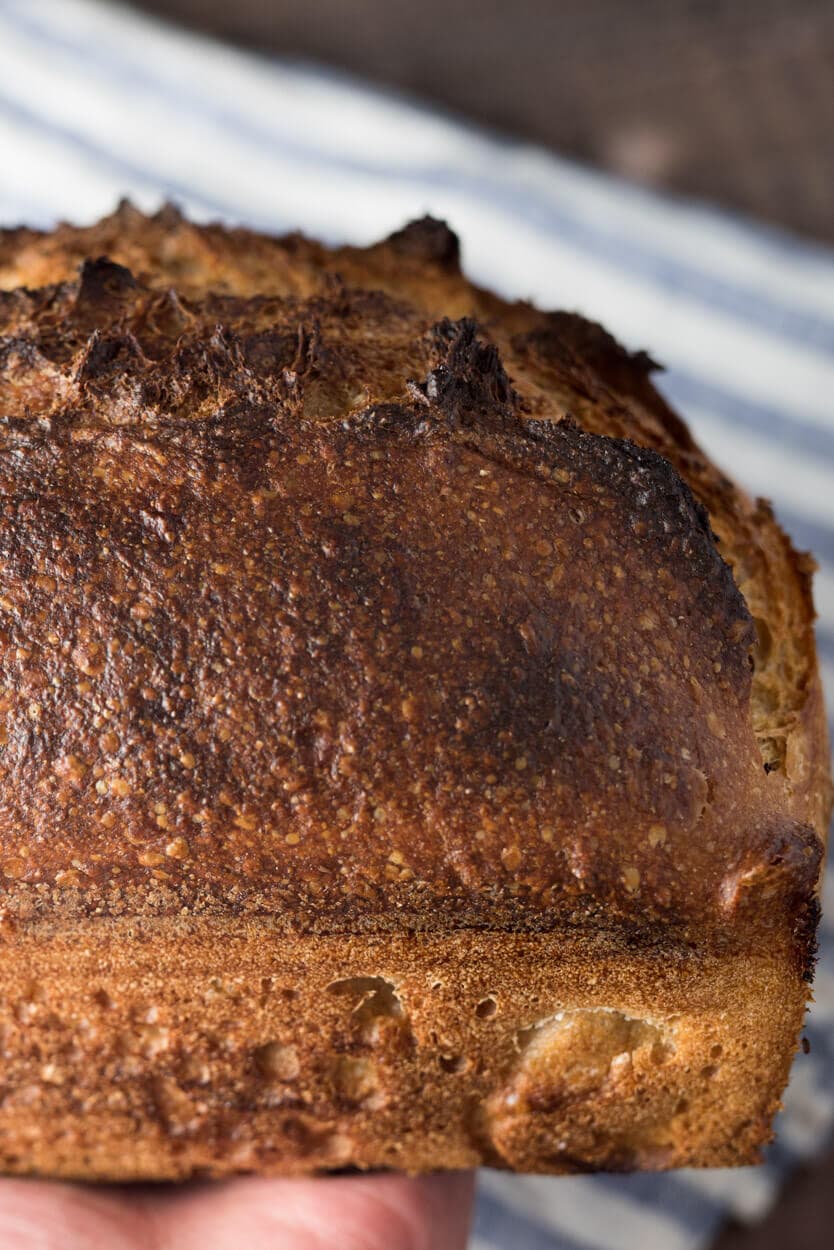
The crust is killer. The intense caramelization is so appetizing it makes your mouth water before you even have a bite. You can see lots of little blisters on the surface of this loaf (thanks in part by the extra steaming in the oven) that provide a little crunch when toasted, a perfect contrast to the incredibly tender crumb inside.
Crumb
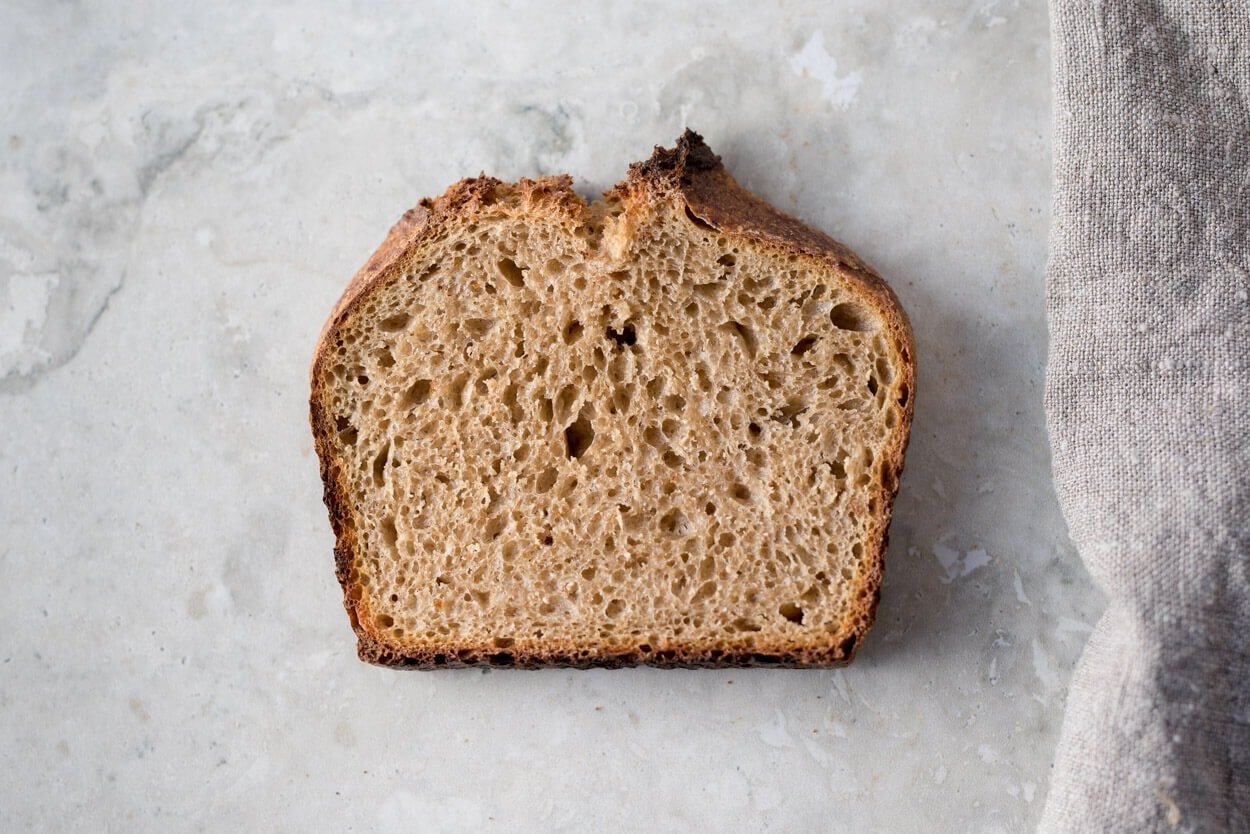
Bread like this asks for a certain level of tightness; it needs to hang on to all those fantastic ingredients you’ll be sandwiching in there. The high level of whole wheat helps ensure a fairly closed crumb but more important is the full scale of fermentation. You’ll notice no dense areas, no gummy sections; everything is well fermented and very tender. If you recall at the start that was one of the criteria I had for this bread and it’s readily satisfied.
Taste
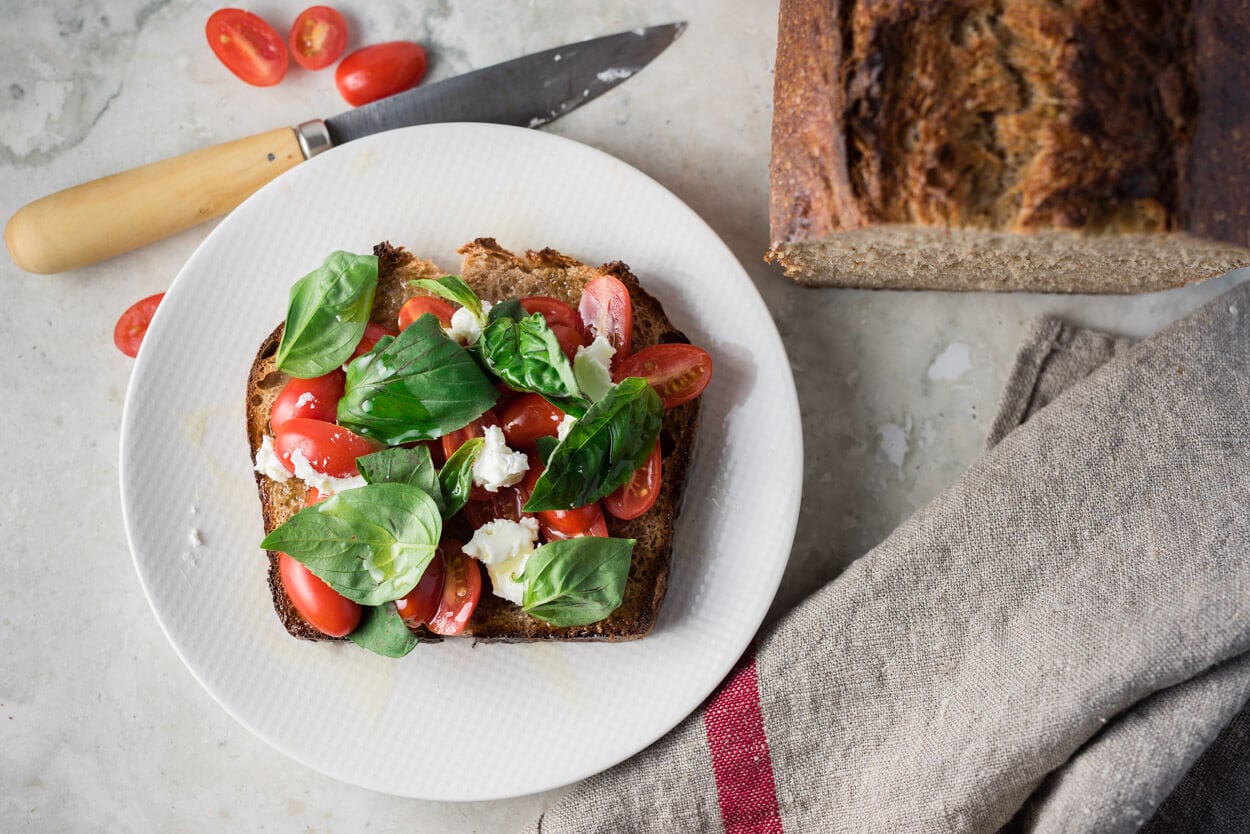
Channeling my smørrebrød history, I made an open-faced sandwich with ripe tomato, basil, goat cheese, and extra virgin olive oil—just perfect for this bread after heavy toasting. Sweet, soft, mellow and contrasting. All part of a bite and all contributing to the grin on my face. I’ve come to enjoy the flavor of Grist and Toll’s Star White Wheat, and I can’t wait to try this recipe with a few other varieties I have, including my own fresh milled white wheat berries. I don’t think you could go wrong with using red wheat instead of white, but as I mentioned previously white wheat has a slightly sweet and more subdued taste that works well with bread like this.
Well, there you have my take on a whole wheat sourdough sandwich bread. I feel like I’ll be tweaking this bread into the future as I already have a few things I’d like to try out: use a large percentage of freshly-milled flour, push fermentation even further (perhaps 2-4 more hours for the final proof), and finally increase the dough weight to 1400 grams to see just how high I can get this bread to climb. Some other welcome additions could be a seed or cornmeal topping and heck, even a little cornmeal mixed into the dough to add another level of sweetness.
Oh! I’d be remiss if I talked so highly about that thick slathering of peanut butter and leave without proof. Once this loaf cooled I was waiting knife-in-hand and it was the first thing I concocted, even the photo couldn’t wait.
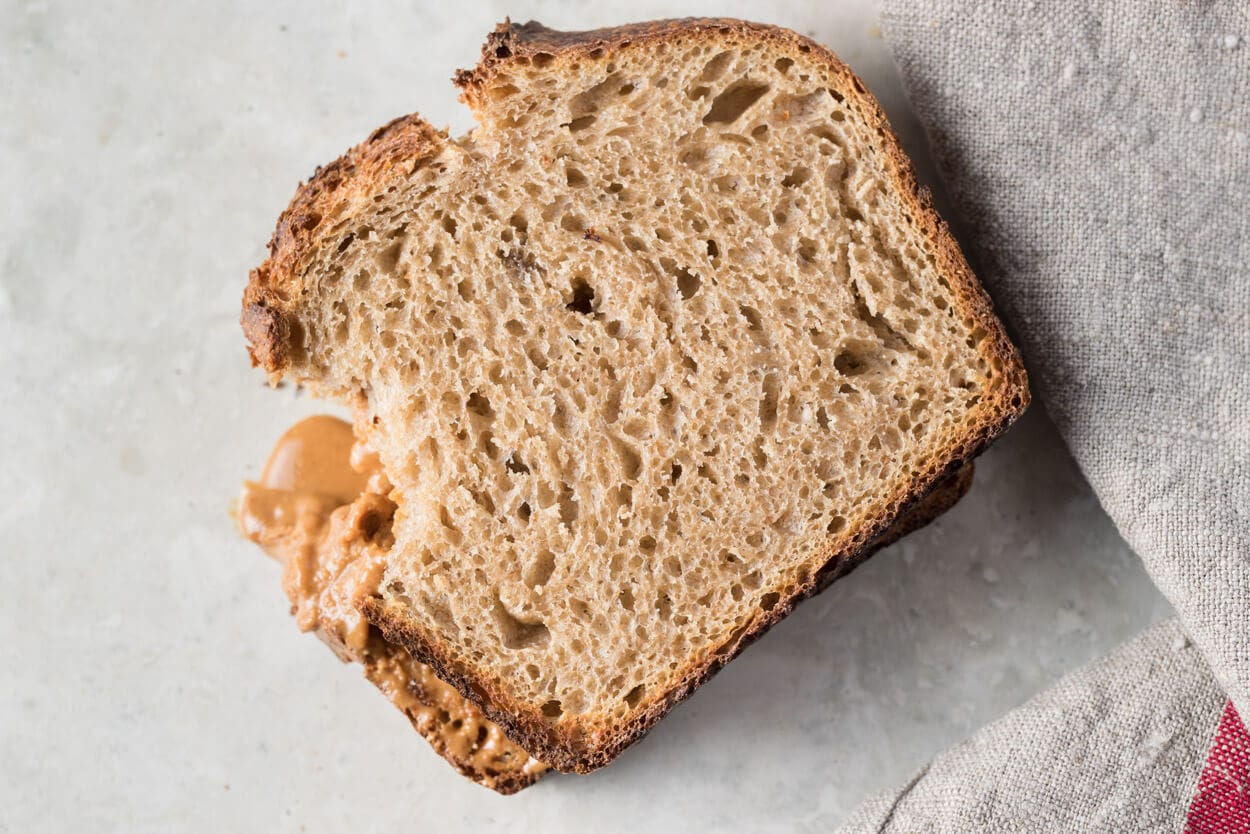
Buon appetito!
If you use this recipe, tag @maurizio on Instagram so I can take a look!
And baguettes too, and I just posted a recipe for baguettes!↩


